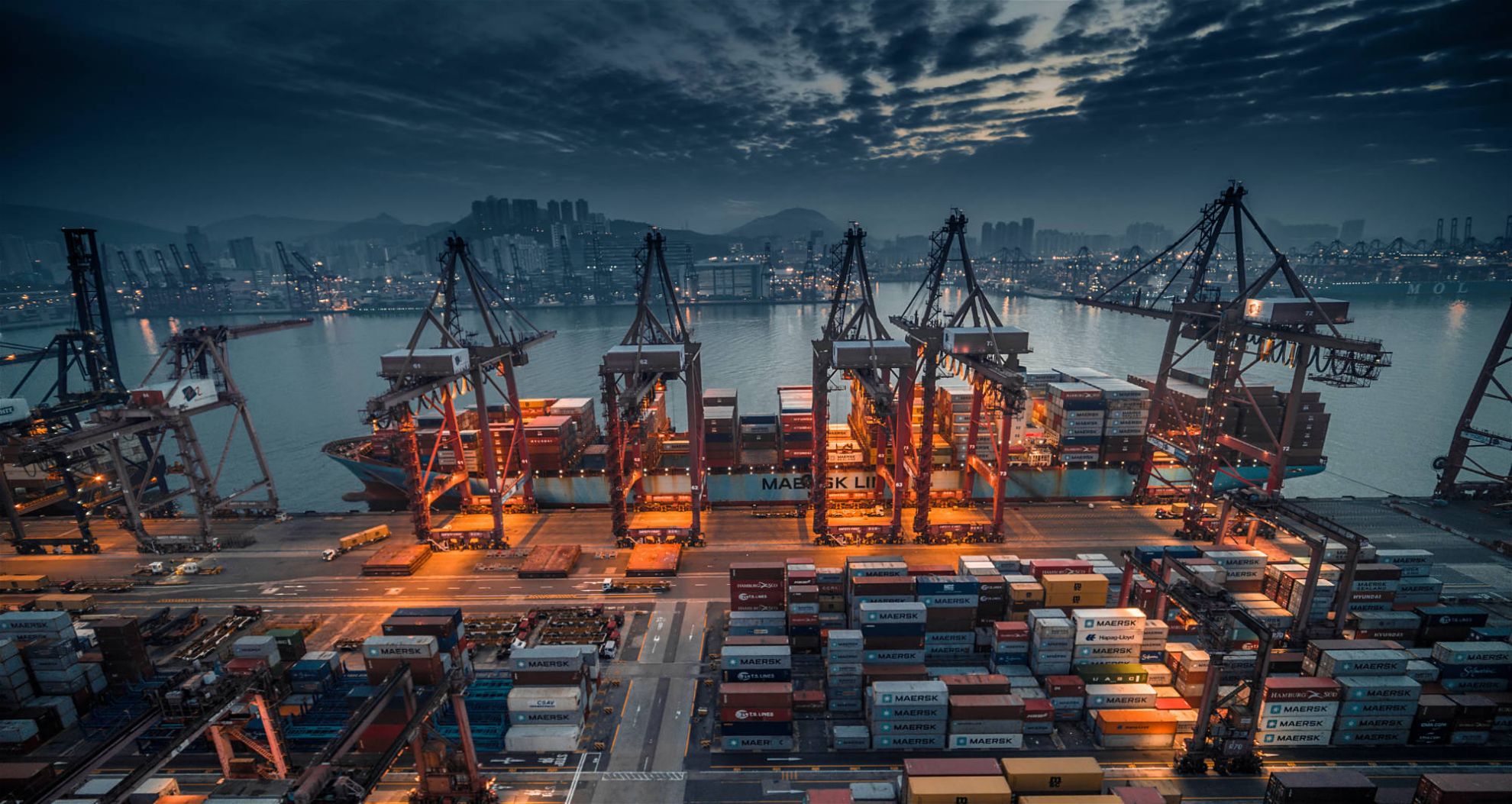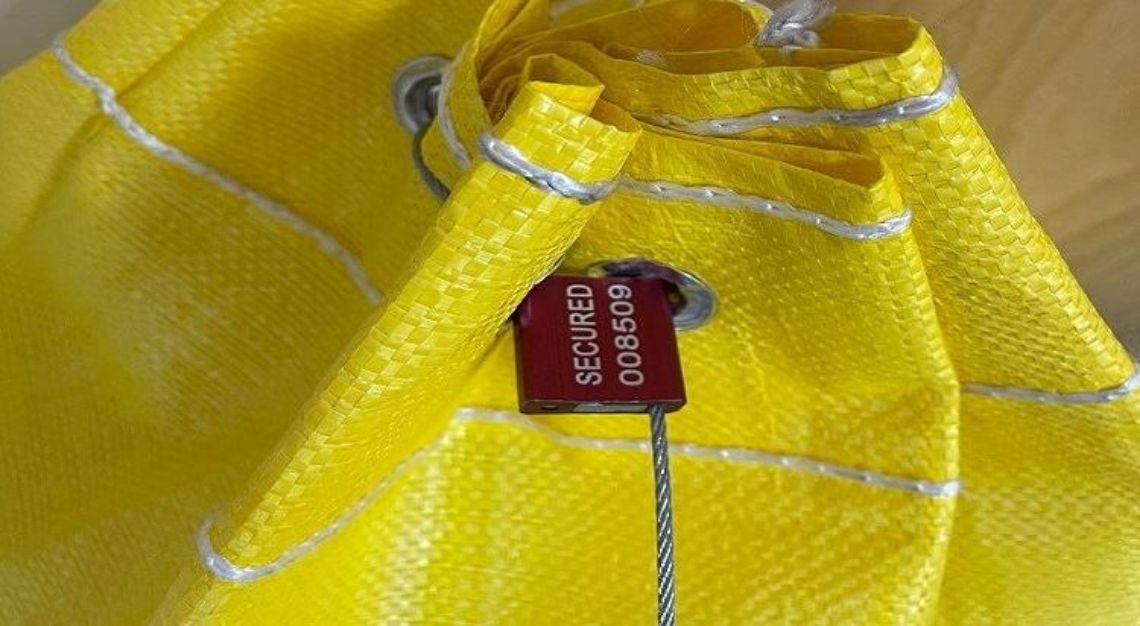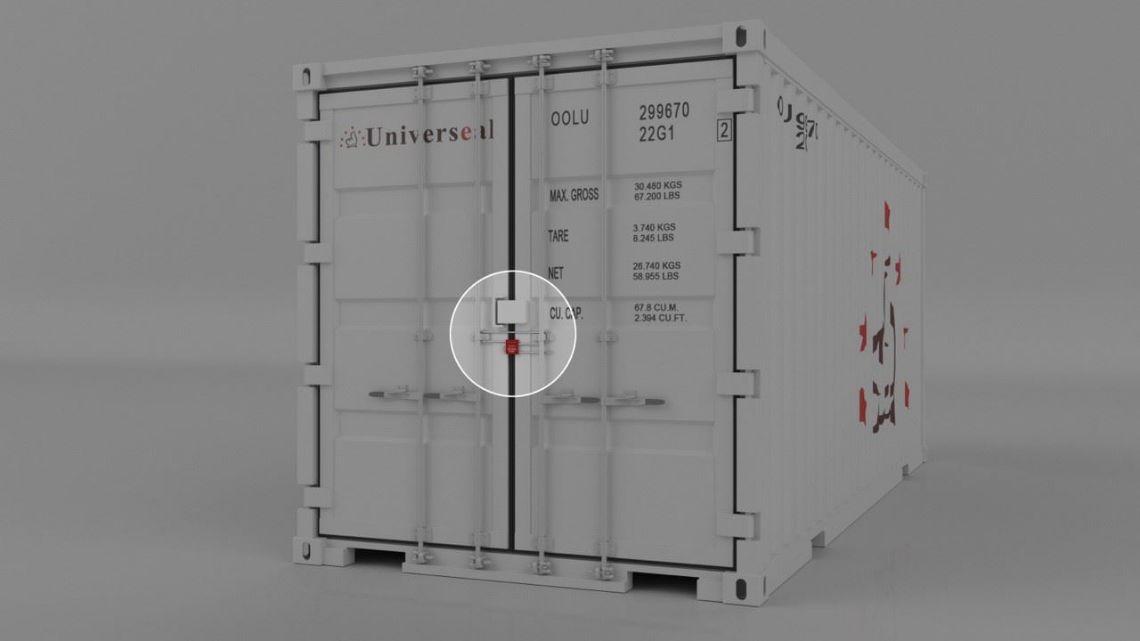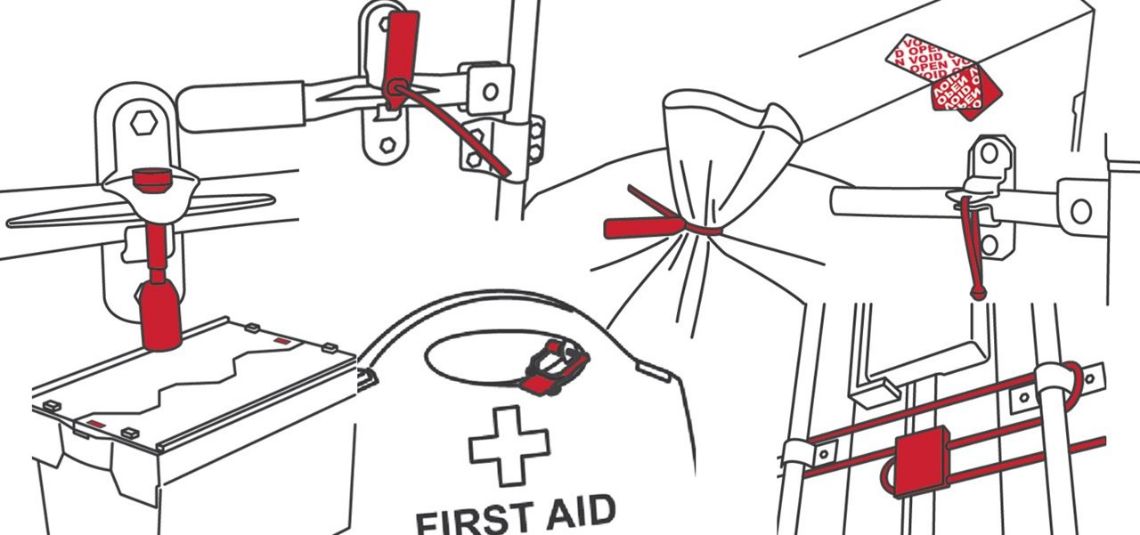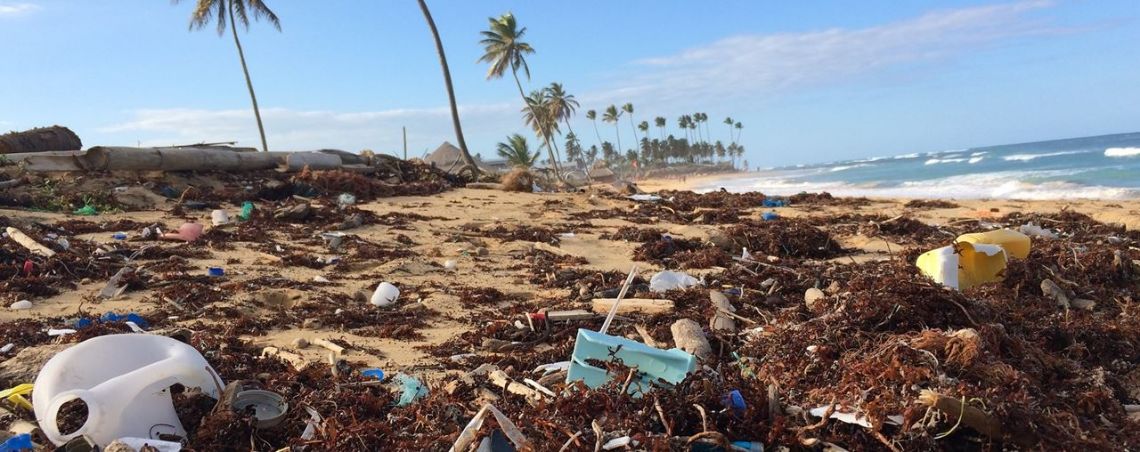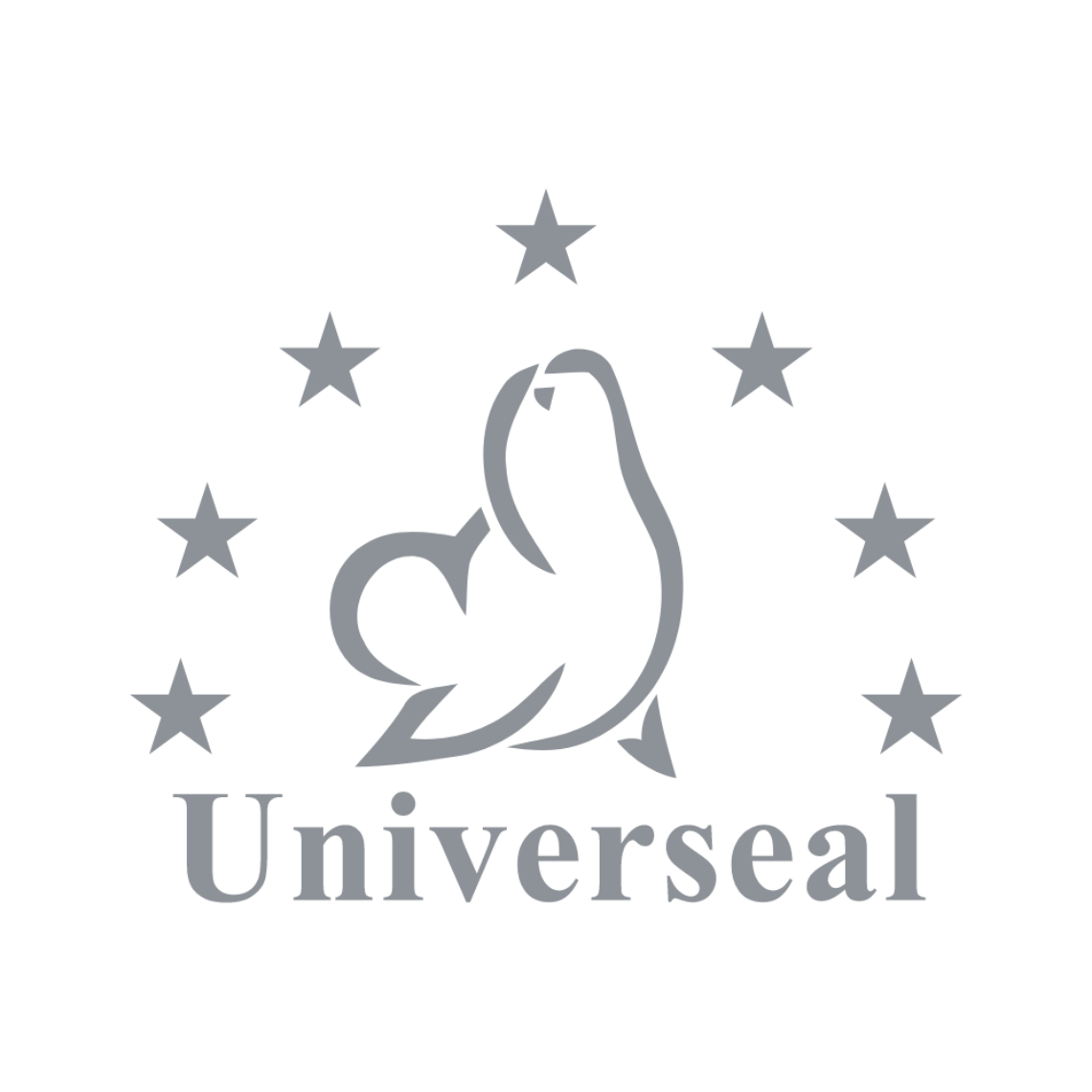Email us
Call us
01829 760000
Top 10 Applications for Metal Cable Seals
We have put together the Top 10 Use Cases for Cable Security Seals, and explain in each case why cable seals are particularly suited for these types of applications.
Cable security seals are flexible and strong types of security seals popular across all types of industries, including freight and transport, food & pharmaceutical, industrial and manufacturing and other sectors. We have put together the below Top 10 Use Cases for Cable Security Seals, and explain in each case why cable seals are particularly suited for these types of applications.
Top 10 Use Cases for Metal Security Seals
| Use Cases of Cable Security Seals | Illustration |
|---|---|
Road Haulage / Trailer Security Cable seals are often used to lock through the locking hasps of road trailer doors, as a stronger solution and more tamper-evident solution than easier breaking pull-through or fixed length trailer seals which can be used alternatively. Our flexiGrip 150M seal is a HMRC Customs accepted seal, and road freight transiting the UK-EU customs borders can utilise customs-accepted cable seals as a cost-effective security seal solution for cross-border road shipments. |  |
Shipping Containers ISO17712 High Security Cable seals are strong barrier seals suitable for sealing of shipping containers transiting customs borders. Cable Seals are sometimes preferred to more conventional bolt seals for shipping containers to provide increased security, particularly for high value shipments involved in food/drink and pharmaceutical logistics: i. Extra-long cable seals can seal around the vertical locking bars, which can provide superior security compared to sealing at locking hasps ii. Our specialised double-locking Flexigrip 500MD is a heavy-duty cable seal which provides a double locking mechanism, for increased security shipments. |  |
Air Cargo Containers Air cargo containers are often subject to vibration, knocks and shocks during air transport and ground movements, and as such lower-strength plastic pull-through seals are not often strong enough to provide effective tamper-evident security. Cable seals provide higher strength security to ensure that seals do not open whilst in transit, providing a full chain of custody of sealed air cargo enclosures from point-to-point. |  |
Rail Cars Cable seals are ideal for sealing individual rail freight car doors. Our range of cable security seals have rugged design features to ensure chain of custody during rail freight movements. |  |
Intermediate Bulk Containers (IBCs) Light-weight cable seals with smaller apertures, for example 1.5mm cable diameters (100S and 150M Models), are suitable for sealing through apertures in Intermediate Bulk Container outlet points. Cable seals seal IBC’s against unauthorised or illegitimate access and maintains the chain of custody of full and empty IBC’s whilst transiting through the supply chain. |  |
Postal and Mail Sacks and Bags Cable seals are well-suited as high-strength pull-through security seals, where the application in question demands increased strength or tamper-evident security. For example, mail sacks might contain particularly sensitive items or cargo requiring the additional strength and tamper-evident protection of cable seals. Cable seals can withstand over 2000KgF of pulling strength force (depending on model) and will not break in transit accidentally. |  |
Bulk Tanker Hatches, Manholes and Valves Chemical and fuel bulk tankers often have multiple points of access, and cable seals are an excellent way to seal these points of access so that legitimate users can maintain an audit and chain of custody of when, how and where tanker contents have been accessed. |  |
Open Top Barrels and Chemical Drums Cable seals can provide a strong tamper-evident lock to sealing the metal clasp mechanisms of open top barrels, ensuring drums remain sealed until delivered to customers, or received back to depots etc. |  |
Valve Lockout Cable seals, sometimes known as “car seals” when used in the context of valve lockout applications, can provide a safe and effective way to isolate valves of all kinds, including quarter-turn, 3,4,5-way valves, gate valves, and butterfly valves. Car seals / cable seals can prevent the actuation of equipment, assisting in isolation and inspection programs. |  |
Pallets & Crates Our StrapSecure cable seal and pallet strapping solution is a convenient and cost-effective way to seal the intersection of strapping which can be used to seal pallets and crates being transported through the supply chain. StrapSecure is particularly suited for sealing of APHA agricultural and pharmaceutical consignments, as they provide security on the individual pallet-level. |  |
See our full range of cable seals for more information.
Please contact us at [email protected] or +44 (0) 1829 760000 to discuss your cable seals requirements today.
Types of Container Seals
Most shipping containers transiting around the world will be sealed by way of a High-Security Bolt Seal, and with good reason. Bolt seals are inexpensive but strong barrier seals which cannot be opened except by application of heavy-duty bolt cutters which physically and permanently destroy a security seal, making reinstatement impossible. Bolt seals are required for international customs movements and must conform to internationally agreed standards for manufacturing good practice, strength and tamper-resistance, as stipulated under ISO17712 “High-Security” and C-TPAT Regulations.
However, bolt seals are not the only kind of security seal which can be used, and for certain types of shipments or in particular scenarios it is more suitable to use other types of security seals for sealing shipping containers, and in this guide we explain why this is the case.
| Type of CONTaiNER security seals | illustration |
|---|---|
Bolt seals are the original form of security seal for shipping containers. They are made up of two separate parts which include the bolt pin and the barrel, supplied together and with counterpart seal numbers engraved on each part. Container bolt seals are locked by pushing the pin into the barrel – the barrel has a self-locking system, and once sealed cannot be opened again; a bolt cutter must be used to open the seal, which permanently destroys the seal and makes reinstatement impossible. |  |
The Fork Seal is another type of seal fully-compliant to ISO17712:2013 HSS (high security seal) for sealing shipping containers. Fork seals provide complete wrap-around protection of container locking bars of any size and offers the highest form of container security; the strong steel can only be cut at the designated cutting point using the very heavy-duty bolt croppers. As one of the stronger barrier seals available on the market today, Fork seals are preferred by some users when sending high-value or high-target shipments globally; for example, shipments of whiskey and other high-value food & drink specialities, as well as valuable or sensitive pharmaceutical shipments. |  |
Cable security seals, also known simply as ‘cable seals’ or wire rope seals, are flexible and strong types of security seals. Our higher strength cable seals (>3.25mm diameter) are as suitable for high-security sealing of shipping containers as bolt seals because they conform to the same ISO17712 High Security standards. Indeed, cable seals can be a higher security solution than bolt seals, because their flexible wire construction and customisable lengths mean that they can seal around vertical locking bars, rather than through container door locking hasps/ cams, which can be susceptible to tamper attempts. As long as a cable seal is progressively tightened as tightly as possible then both doors are sealed shut and cannot be opened, regardless of any attacks on locking hasps or locking cams. Additionally, we also supply our double-locking Flexigrip 500MD, which provides two locking mechanisms within one seal, for a superior sealing solution. |  |
Our Globe seal is a robust all metal strip security seal, providing secure protection for shipments in transit, including for sealing of trailer doors and railway cars. It is a reliable and immediate indicator that goods have been received as sent. The seal features a locking mechanism totally enclosed in the head, which is secured by two independent spring rings. The seal is applied without the need of tools and is certified as an ISO17712: 2013 'indicative' classified security seal. |  |
Plastic Security Seals for Shipping Containers Plastic seals are indicative in nature – whilst they provide clear evidence of tampering, they can easily be cut and broken, and so serve as a visual indication of tampering rather than being a barrier to entry. As such, they are often thought to not be appropriate for container security. However, this is not always the case! Shipping containers are not always under customs control; once shipping containers have arrived to port and have been customs cleared, they have entered into free circulation into the domestic market, and are making domestic onward journeys, in a similar way to road haulage trailers. Plastic security seals can then serve as a tamper-evident, easily accessible solution which continues to provide a level of security to the container, without being as heavy-duty or costly as container bolt seals. Another example is using a plastic security seal a tamper-control check on empty containers returning to depots or terminals. Popular models include our DoubleLock seals and FleetLock seals. |
|
Container Locks Keyed Container Locks are the strongest possible types of lock, because they are keyed and are designed to be used many times over many shipping container consignments. Like all keyed locks, container locks have a disadvantage in that it relies upon of appropriate security and availability of the access key; but they do have their uses in particular scenarios - please contact us should you like further information on the types of container locks we can supply. |  |
Display
per page
Types of Security Seals
The range and different types of security seals and tags can be confusing to the uninitiated, so we have produced the below quick visual guide for understanding some of the key differences, and how particular types of security seals might be suited to use cases in your organisation. For further help and assistance, please contact us at [email protected]
 | .png) | .png) |
| Plastic Indicative Seals, 2 types: (1) Pull-Through Seals seal through locking chamber & pull progressively tighter, suitable for sealing of mail & cash bags; (2) Fixed Length Seals form a fixed loop, suitable where over-tightening might cause accidental breakage in transit (such as trailer hasps). | Security padlock seals are fixed length seals which are small and suitable for sealing of small enclosures like trolley apertures, first aid and other equipment kits, security bag zippers etc. They can easily be sealed and broken by hand for quick and convenient application. | Bolt security seals provide barrier control for shipping containers. They consist of a counterpart barrel and pin with duplicate numbering, sealed together and requiring bolt cutters to remove. They must meet ISO17712 high security standards and are suitable for cross-border customs movements. |
 | 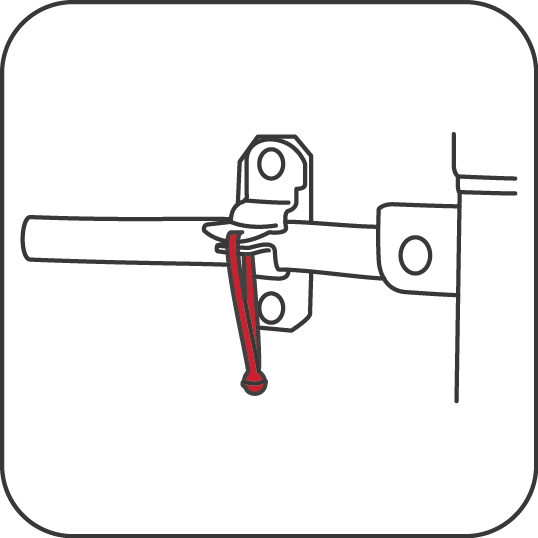 | 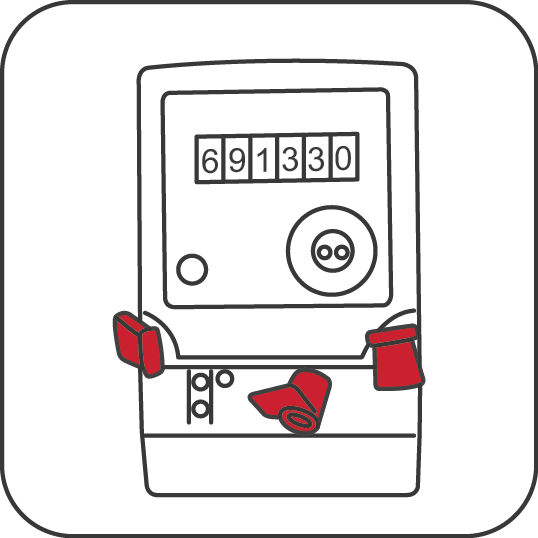 |
| Metal Cable seals are strong barrier seals, and in their heavier gauge options (Flexigrip 325M and Flexigrip 500M) are also ISO17712 'High Security' approved for customs movements. The pliable wire cable can be flexibly used to seal through hasps and around vertical locking bars, providing increased security. | Metal strip seals are useful option between plastic indicative seals and heavier duty cable and bolt seals - they provide a higher tensile strength of between 50KgF - 100KgF compared to plastic seals, but are most cost-efficient compared to cable and bolt seals. Their thin straps make them well-suited for sealing small apertures, such as TIR cords and railcars. | Meter wire seals are products suited to sealing utility (gas and electric) & taxi meters. They range from simple plastic and metal seals which can be crimped onto sealing wire with pliers, to more sophisticated self-locking seals with inner mechanism. Wire seals are produced with narrow gauge wire to fit through the small apertures of meters (<1mm). |
 | 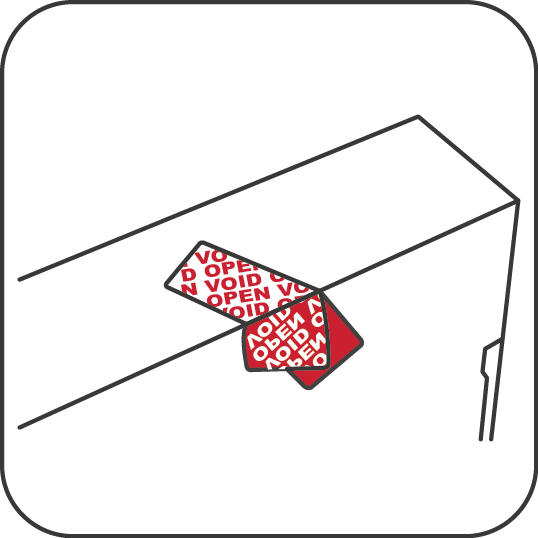 |  |
| Tote box plug seals are a specific type of fixed length seals designed to securely seal the lids of attached lid containers (ALC's) firmly shut. Plug seals seal down flush on to lids, making stacking of tote boxes easier, and can also be produced with paired numbering to seal both of end of the crate with the same security number. | Security labels and tapes are their own category of security seals which work on the basis of their tamper-evident film and adhesive properties, rather than by mechanical anti-tampering. By their nature, they are suitable for sealing flat surfaces, such as carton and pallet seams and edges. | Electronic seals are their own subset of security seals which use electronic sensors to detect a tamper-evident state. They are generally reusable seals with a higher initial cost which is spread over many thousands of uses. |
Choosing the Best Security Seal for the Job
With the range and breadth of security seals on the market, it can be very challenging for the uninitiated to know which seal to choose to best suit their needs. From the outset, it is recommended that the decision-maker considers the purpose of the security seal in relation to the application. Considering some of the fundamentals from the outset will help to select the right seal for the job…
…why is the user sealing the enclosure in the first place? Is it for loss prevention, safety purposes, product integrity, brand assurance...?
…what type of goods will be protected? What is the value of the goods?
…where is the seal going, and how? Cross-border shipments are subject to customs regulations which will affect the seals that can be used
…what kind of resistance is required? What are the consequences should if the security seal has been broken or tampered with?
…what environment is the seal being used in? What is the operating temperature? How long does the seal need to last for?
Answers to these questions will have a bearing on the material, form, shape, strength of the most appropriate security seal.
It should also be noted that a security seal alone cannot provide an iron-clad guarantee of integrity. No manufacturer anywhere in the world can say with complete certainty that – given enough time, appropriate circumstances, resources, skills and ingenuity – their security seals are undefeatable... but this is also true of safes, door looks, padlocks and alarms. Security seals should always be used as one layer within an ‘onion skin’ of security (view our guide to security protocols).
With this said, below we note some key characteristics of seals you should consider when choosing the most suitable. Try out our handy filtering tools shown on our main security seals category to find a product matching your needs.
| Seal Feature | Considerations |
|---|---|
| Design Type | Seals come in many forms... Pull-through Security Seals, Fixed-Length Security Seals, Security Padlock Seals, Barrier Seals (Cable Seals and Bolt Seals), Wire/Rope Meter Seals, and even Reuseable Electronic Seals. Security seals also include security tapes and labels, suitable for flat surfaces and edges on enclosures such as crates, cartons and pallets. Each type is designed for particular types of applications - for more information, see types of security seals. |
| Physical Fit (Diameter, Length and Flag Size) | Each security seal will have a particular tail or hasp diameter, an effective useable length, and a standard flag size for visibility of printed identification markings. Narrower seals are useful where seals must fit into smaller apertures, and for this many of our pull-through seals have smaller diameters, such as the MiniLock 570's 1.4mm tail thickness and UniTite 414's 2mm thickness. We also offer extra long seals, such as the UniStrap 412-XL (overall 51cm length) and UniTite 413 (overall 49cm length). In terms of flag size ("marking area"), we offer specialised security seals such as our UniFlag Security seal, which has a large format (108x56mm size). |
| Material | Common materials in use for security seals are polypropylene, nylon, aluminium and steel. Polypropylene is a popular choice for pull-through seals, as it offers a combination of strength, flexibility and wide operating temperatures. However, all types of plastic do become brittle at increasingly low temperatures, and do degrade when exposed to UV light, long-term saltwater exposure, solvents etc. Metal aluminium and galvanised steel cable seals provide more durability and strength where circumstances dictate, and we can also specify stainless steel cable grades for most demanding applications: see our Flexigrip 150M and Flexigrip 325M models. |
| Strength | Seals are specified for particular strengths – for certain applications such as fire extinguishers, kit bags and first aid trolleys it is desirable to have a very low break-strength so that seals can be broken in an emergency – for others, for example mail sack security seals, it is important that seals with strong break strengths are used so that bags do not burst open when under tension. There is a wide range of tensile strengths available, from 5KgF all the way up to 2000KgF, so understanding the possible forces relevant for your application is important for specifying the right kind of seal. |
| Level of Tamper-Evidence | We categorise our security seals as having either a Low, Medium or High degree of tamper-evidence, based on design and construction features, method and material of construction, and level of certification. |
| ISO Classification | Linked to the above, higher levels of security seals are often required for international freight movements - in particular, High Security Seals as classified under ISO17712:2013 regulations for international shipping container and freight movements. |
| Removal Method | Some applications require easy-access into a sealed enclosure, and for this we have security seals that can be removed easily by hand, either with low-break strengths (see our Fireseals) or tear-line features (see our Tracewaste Tear-Off and UniStrap 412LT). For other requirements, security seals need to be robust and should not be removed intentionally without simple tools such as scissors or tin-snips, such as our UniTite 413. In other scenarios, particular for barrier seals, we have our heavy-duty cable and bolt seals, products such as our Flexigrip 325M, Flexigrip 500M and Fork seals which necessitate the use of heavy-duty cutting tools like bolt croppers to remove. |
| Sustainability | Sustainability should of course be at the heart of every business, and security seals should be no exception. All of our plastic security seals are 100% recyclable, and we are increasing options for recycled content and biodegradable security seals on a regular basis. |
Universeal UK has been supplying security seals since 1992, and we are one of the leading organisations in the industry. Please email [email protected] for more information on our range and how we can assist. For advice on using security seals within a wider security program, please continue reading our next article in the series, Security Protocols: Making Security Seals work for You.
This article is the second of four, looking at how security seals can fit within your wider security protocols. View Series below...
- What are Security Seals?
- Choosing the Best Security Seal for the Job
- Security Protocols: Making Security Seals work for you
- Glossary – Understanding security seal terminology
What Exactly are Security Seals?
Definition of a Security Seal
Put simply, security seals provide a tamper-evident chain of custody for cargo and valuable assets in transit or in storage. They are devices that ‘seal’ enclosures to protect them from interference, maintaining the integrity of supply chains from loss, theft and other manipulation. Sealed enclosures can take many forms – including sacks, truck trailers, shipping containers and tote boxes – but what all enclosures share in common is that they encase sensitive items such as goods in transit and are the appropriate point to seal against unauthorised access.
Tamper-Evidence Function
Security seals, when used properly as part of a wider security protocol, serve two key functions. Firstly, they are tamper-evident or tamper-indicating, in that they are designed to permanently demonstrate physical evidence if interfered with – usually by tell-tale signs of breaking or other physical change of appearance, such as a ‘blushing’ on the surface of plastic seals when subject to manipulation or deformation.
These types of seals are sometimes simply called ‘indicative’ tamper-evident seals because their physical appearance indicates their status and that of the sealed enclosure. Indicative seals are easily broken or cut open with readily available light tools such as scissors. Indicative seals are used in many sectors, but commonly used to seal sacks and bags, domestic truck and trailer movements, fire extinguishers, roll-cages and crates.
Access Control Function
Security seals also serve a second access control function, reducing the occurrence of unauthorised access of sealed enclosures. They do this above all by their mere presence – well-placed seals serve as a psychological deterrence to access, simply by making individuals think twice about the consequences and what might happen should they ‘unseal’. Beyond this, a sub-category of seals called ‘barrier seals’ also provide an actual physical barrier to entry, acting like a specialised single-use lock which requires cutting tools to open, such as metal bolt and cable seals. Shipping containers, rail cars, and cross-border truck and trailer movements are the most common commercial uses for barrier security seals. Barrier seals physically prevent an illegitimate opportunist from opening the enclosure easily. These types of barrier seals are frequently referred to as ‘high security seals’ – these are security seals which meet the ISO17712:2013 ‘H’ ‘High-Security’ classification. This is an international standard setting out the strength, tamper-evident characteristics and other manufacturing standards which seals must meet in order to suitable for international customs movements, including US-bound consignments under C-TPAT regulations.
What security seals are not…
It can also be useful to define security seals by reference to what they are not.

Security seals are not just like padlocks. Keyed padlocks – often stronger than seals – are much more expensive, and also much more easily replaced. Unlike a security seal, most padlocks are not uniquely numbered or marked, so they can be broken and replaced leaving no sign that unauthorised access has occurred. Additionally, the key itself presents a problem – keys can be duplicated, borrowed, lost or simply unavailable when needed – and in each case this presents issues. Security seals can simplify security processes because they are low-cost, uniquely identifiable security devices which are designed to be sealed once and then broken once, at the appropriate times.

Nor are security seals just a different kind of cable tie. Cable ties are very different products and are ideal for particular use cases, but they should not be used as a security seal – cable ties can very readily be undone (and thereby re-tied in a matter of seconds…) because they have not been designed for tamper-evidence.
Security Seals Big and Small..
 |  |
It is worth noting that security seals don’t come in any one particular form – they can range from simple void security labels or stickers suitable for application on flat enclosures such as pallets or carton seams, all the way up to heavy-duty metal construction container barrier seals...
…As long as it is a tamper-evident device which controls access to enclosures, then it is a security seal!
Universeal UK has been supplying security seals since 1992, and we are one of the leading organisations in the industry. Please email [email protected] for more information on our range and how we can assist. For advice on choosing the right security seal for your particular needs, please continue reading our next article in the series, Choosing the Best Security Seal for the Job.
This article is the first of four, looking at how security seals can fit within your wider security protocols. View Series below...
- What are Security Seals?
- Choosing the Best Security Seal for the Job
- Security Protocols: Making Security Seals work for you
- Glossary – Understanding security seal terminology
Environmentally-friendly, biodegradable security seals
Universeal UK pioneers biodegradable security seals
Universeal UK has begun incorporating environmentally-friendly plastic technologies into our plastic security seals to mitigate against the environmental hazards of single-use plastics.
Awareness of the environmental damage caused by single-use plastics, especially in our rivers, lakes and oceans, has rightly taken centre-stage in the public consciousness in recent years. Whilst most security seals are manufactured from materials which are 100% recyclable, the difficulty of responsibly recycling security seals which might travel all over the world with their cargos has presented a major challenge for the security seal industry.
Formulating single-use plastics which can properly degrade into harmless by-products has been a major goal of the industry, but has been a technical challenge to solve. Whilst supposedly “biodegradable” and environmentally-friendly “green” plastic security seals have been around for years, unfortunately the materials they are made from have not always been the cure-all which some would claim.
The problem with many supposed green plastics is that they can actually contribute to the problem of plastic waste. For instance, “oxo-degradable” plastics have actually contributed to the problems of micro-plastics in recent years, and have been banned through many parts of the world. Similarly, other supposedly green “compostable” plastics only actually bio-degrade in special industrial composting facilities, which break the plastic down by using a combination of oxygen and heat. However, this means that if the plastic goes to normal landfill (of which around 80% of plastic still does) it will not biodegrade, as in such landfills there is not enough oxygen or heat to do the job of breaking the plastic down. The plastic therefore continues to persist for many hundreds or thousands of years in landfill. Alternatively, they are simply burnt and thereby release the carbon and other damaging substances which any other type of plastic would do. A further serious problem with these types of compostable plastics is that they cannot be recycled along with other types of conventional plastic – meaning that they can potentially cause more harm than good.

Over the last few years Universeal UK has been monitoring the development of technologies which can provide a better solution for single-use security seals. We are pleased to report that we have identified a revolutionary type of additive which can be incorporated into plastic security seals and can successfully biodegrade the plastic in the environments in which discarded security seals are commonly found: our landfill sites, or even worse, our oceans. The additive - which can be added to conventional plastic without affecting its properties - acts to break down the plastic even in anaerobic environments, once exposed to the types of bacteria commonly present in all types of conventional landfills, oceans and streams.
Once in contact with this bacteria, plastics can start breaking down as quickly as 30 days from their time of entering into the environment – this is in contrast to conventional plastic which persists for hundreds if not thousands of years. Test reports are showing that on average biodegradation is 200 times faster with the additive. By-products left behind are humus and methane (bio-mass and bio-gas), which are non-toxic; humus can actually be used as new soil to grow plants, and methane may be harvested into fuel. Independent third-party tests have shown that the additive conforms to ASTM 5511 testing standards, which is an internationally-recognised measure of biodegradation in anaerobic conditions prevalent in landfill environments. Reports showing biodegradation rates for particular samples are available upon request.
We are now offering production of the below security seal models with inclusion of special biodegradable Biosphere additive:-
 | TabLOCK 20cm and 30cm Multipurpose security seal available in two lengths, with/without tear-line... now available with Biosphere biodegradable additive. |
 | UNI411 Security Seal Multipurpose security seal for roll cages, trucks and trailers... now available with Biosphere biodegradable additive. |
 | UNI412 Security Seal Our strong pull-though security seal for cash bags, mail sacks, waste sacks, trucks.. now available with Biosphere biodegradable additive |
 | Uniflag Security Seal Large flagged security seal, suitable for mail, industrial and labelling applications... .. now available with Biosphere biodegradable additive |
Biodegradable, environmentally-friendly and recyclable security seals will help you to reduce your use of conventional environmentally-damaging single-use plastics in your supply chain.
In addition to biodegradable security seals, we are now offering another environmentally-friendlier, lower carbon solution for your security seals - seals manufactured from recycled content plastic material, with at least 30% of plastic material coming from post consumer recycling sources. Please read our blog here to further information. Our range of sustainable security seal solutions is shown here, showing both our recycled-plastic content and biodegradable security seal options.
Please contact us at [email protected] to discuss your requirements and how we can help your business to improve the impact of its operations around the world.
Car Seals for Lockout of Safety-Critical Valves

“Car seals” are single-use security cable seals, so-called due to their alternative use in sealing railway cars, or wagons. Such car seals can also be used in the safe and effective lockout and isolation of industrial valves. Our Flexigrip 325M car seal is available from UK with unique sequential numbering and 1m length cable for safe and secure sealing of valves.
Car seals perform well as single-use lockout devices to seal a valve in the open or closed position, typically for long durations - for example, to permanently secure a sprinkler system valve. To remove the car seal, a cutting tool is required, after which the cable will splay, ensuring that the device cannot be re-used. This effectively prevents unauthorised use of the valves, where this may be dangerous without appropriate safeguards.
Below is a visual guide to the use of car seals for valve lockout:-

Colour coding is used to indicate the safe working position of the valve, for example green for valves which should be kept in the ‘open’ position, red for ‘closed’ valves, and yellow for ‘throttled’ valves – however, a range of custom colours available upon request: this may be preferred to indicate other important information, such as the substance flowing through pipework.
Car seals for valve lockout come in a standard 1m length cable – but custom lengths are available, to suit particularly large operatus or to seal multiple valves in one operation.
In order to provide safe working practice, a system of working should be implemented to provide a full auditable record of safety lockout. For example, a regularly updated list of safety critical valves should be maintained, recording the following information.
- Safe position of valve, e.g. open or closed
- Valve location / department
- Last inspection date
- Unique identification number of the car seals
This is to ensure that you meet your responsibilities under national occupational safety legislation. For example, in the UK, the Provision and Use of Work Equipment Regulations 1998 (PUWER), provides for safe working practices - particularly the provision of machinery with appropriate and safe methods of control, and the safe isolation of machinery from all energy sources, as required. Car Seals can act as a suitable tool as part of your health and safety protocols to ensure that your workforce is protected, and that you are in compliance with safety legislation.
If you require another type of solution to suit your particular needs, we do offer other products for valve lockout - our full range is available here.
Please contact us to discuss your requirements - [email protected] or 01829 760000
Securing the Skies - Security Seals for the Airline Industry
Security seals are a key component in the securing of global aviation logistics, ensuring that aircraft, airports and airline supply chains are secured against the issues of tampering, theft or bad practice. They serve as a means by which an audit history of logistics movements can be maintained so that authorised users might understand where risks under their area of influence might be managed and reduced.
Overview

View Larger
Security Seals in Use
 |
Airplane doors should be sealed overnight whilst unattended to ensure that no-one has accessed the aircraft without prior approval. Security labels can be used to seal the seam of the doors in this scenario to ensure that access is notified and recorded. Non-Residue Security Labels cannot be unpeeled or removed without the label delaminating, showing VOID through the surface of the label, but does not leave any unwanted residue on the aircraft itself. |
 |
| Air freight / air cargo containers are subject to rugged handling, logistics movements, in-flight turbulence, and more. Choosing the right security seal is therefore very important, and seals with sophisticated anti-tamper features and high-pulling strengths only should be used. Universeal UK recommends the application of single-use variable length cable seals in this scenario. Cable seals are much stronger than plastic pull-through seals, featuring pulling strengths ranging from 330+ KgF to 2000+KgF. Cable seals can only be removed using appropriate cutting tools, which prevents access by unauthorised users and other opportunists during transit, and can easily withstand the forces and rigours of airfreight logistics. |
 |
Ground operation logistic vehicles, such as trucks and trailers, should be sealed with indicative plastic seals to prevent intrusion once within airport boundaries. Universeal recommends the use of pull-through seals with metal and acetal inserts due to the higher level of sophistication they provide, giving clear evidence of tampering. Pull-through security seals are available in different lengths, pull-strengths and with/without tear-off facilities, to suit the particular requirement. |
 |
| Waste or equipment collection bags and sacks should be sealed with printed identification ties or security seals to provide safe transport, recycling/reuse or disposal of all manner of items which are bulk-bagged in the course of main airline and airport operations, or operations ancillary to this. Products can be customised to suit your particular needs – with printing of company name, logo or text; unique sequential numbering and barcodes; as well as packaging to suit operational requirements on the ground. |
For more information, please visit the airline section on our website, or download our leaflet Security seals for the aviation industry to keep for your records.
Cargo Security: Sealing Vans, Trucks and Trailers
Cargo Security: Sealing Vans, Trucks and Trailers
Securing your assets against theft and interference whilst in transit is more important than ever in our globally-connected world. Security seals are an important part of the security process; helping to ensure that your goods arrive at destination as expected, without delay.
Security seals come in various forms to suit particular applications, and in this article we run through the different types of seals which are suitable on various forms of road transport vehicles.
Transit and Small Van Security | |
 | Security LabelsSmall transit and other small courier vans do not feature locking hasps or other features which would allow for sealing by way of an indicative pull-tight or fixed length seal. Instead, non-residue security labels can be placed on the seam of vehicle doors, preventing access without removing the label and de-facing the surface, leaving a VOID message through the seal. Non-Residue labels have the advantage in that they do not leave a residue on the surface of the doors, avoiding damage to paintwork. |
Vans with Roller Door Shutters |
|
 | Indicative Pull-Tite SealsVans and other vehicles with roller-shutter doors feature hasp and staple-style locking arrangement. For these types of locks, we recommend use of a pull-tite or “pull-through” tamper-evident seal, which can be secured tightly around the mechanism, preventing interference by opportunists. Pull-through seals are available in many different sizes and configurations. We hold most items in our UK warehouse; alternatively, we can customise with your bespoke marking, logo and custom numbering. |
Articulated Lorry Trailer Doors | |
 | Fixed-Length / Ring SealsTrailer doors are available with a number of different locking mechanisms, and so the preferred security seal will depend on the mechanism in question - either pull-through or fixed-length seals are recommended. Fixed-length or "ring" seals, form a secured loop through a locking aperture. Ring seals do not “pull tight” around the locking arrangement, meaning that they can be freely rotated, checked and inspected for signs of tampering more easily. |
Curtain-Siders | |
 | Fixed-Length Seals and TIR CordsCurtain sided trailers are best secured using a TIR cord to pass through each of the buckles along the trailer, looping around so that TIR fasteners can be secured at the back of the vehicle using a plastic indicative fixed-length seal. This ensures that the only way to access any side of the trailer is by way of breaking the seal, providing the audit trail required. |
Containers on Trailers | |
 | High-Security Bolt Seals & Plastic Indicative Seals (empty loads only)Fully-loaded shipping containers which are being moved internationally require sealing by way of a security seal designated and tested as ‘high-security’ according to ISO17712 and CT-PAT regulations. Our high-security bolt seal is one of the most well-established on the market and fully compliant. For empty loads, we recommend use of plastic indicative seals – providing peace of mind that empty containers have not been accessed against the knowledge of the legitimate user, reducing risk of foulplay. |
Open Top Containers |
|
 | TIR Cords & Plastic or Cable SealsOpen Top containers allow bulky items to be loaded directly from above. They usually covered and secured using a tarpaulin. TIR cords should be used to pass through the tarpaulin cover eyelets and around container corner posts or lashing rings. The TIR fasteners can then be secured with a security seal – either an indicative plastic seal, or where the goods are being shipped internationally, a high-security bolt seal or cable seal. |
Oil, Gas & Bulk Liquid Tankers | |
 | Flexible Cable SealsThe valuable and potentially hazardous contents of tankers are at risk of interference, theft and fraud, especially whilst in transit and away from the legitimate user. This makes it crucial that sensitive and valuable access points, such as valves, meters and hatches are strongly secured against tampering. Flexible, variable length and very strong cable security seals are ideal for ensuring such access points are secured against interference. |
Security Seals and Identification Tags: what’s the difference?
Security Seals and Identification Tags: what’s the difference?
To put it simply, security seals are used in applications in which a tamper-evident solution is required to ensure that the sealed items cannot be accessed without the knowledge of the authorised user. Identification ties, on the other hand, are products designed to fasten around bags, boxes and other items to keep them closed – they are not designed to be tamper-proof, although they can be uniquely printed to identify assets or communicate information to a user.
What is a security seal?
Security Seals; as the above suggests, are used to secure something: this could be anything from sealing a locking hasp on a door or a first aid kit, to a shipping container or oil drum.
A true security seal is not exactly designed to stop unauthorised access to something but rather to make it extremely difficult to access a sealed enclosure without the seal showing signs of having been tampered. This is achieved by engineering the security seal – and in particular its locking mechanism – in such a way that external manipulation is very difficult once the seal is in situ (without simply breaking the seal). As an example, our Tracewaste seal features an encapsulated locking mechanism to prevent tampering.
However, tamper-evidence alone isn’t enough. More often than not a security seal will have its own unique serial number. As an example, a logistics haulier might wish to seal curtain-sided lorries with a uniquely numbered security seal; record the particular serial number at its origin; and then ensure that the same seal is intact without signs of tampering at the arrival destination. This reduces the risk that unauthorised users might replace a security seal whilst in transit. As well as sequential numbering, users might opt to use their company logo / other markings to uniquely identify the seal.
Not all security seals are made equal.
Security seals are designed with particular applications in mind. Some seals, such as the Fireseal are designed for very low-break strength and are purely “indicative” in nature. They are easily opened, and particularly suited to applications where immediate access is required: sealing fire extinguishers, medical crash trolleys, and spill kits are all typical examples of their use.
Certain seals are intermediate in nature: combining indicative tamper-evidence with a medium-to-high level of physical strength (for example, featuring a pulling resistance of greater than 40 Kgf). Such seals require removal by way of cutting snips or by way of a specially designed tear-able parts of the seal. Our UNI-412 and UNI-413 seals are examples of such products.
At the other end of the scale, some security seals are designed with much higher physical resistance in mind, so that only specialist bolt and cable cutters are suitable to remove the seal. Specifically, in most cases where shipping containers are being moved internationally, security seals must adhere to the “high-security” ratings applicable within the ISO 17712:2013 standards. For example, our Locktainer 2020SH bolt seal is fully-compliant with ISO17712 and CT-PAT regulations. These regulations ensure that container seals have been rigorously tested for their strength properties and their resistance to common methods of interference.
You can read more about such compliance in our blog: Compliance with C-TPAT and ISO 17712:2013 Standards for High-Security Seals.
Security seals also come in different shapes and sizes. As well as the pull-through plastic seals and high-security bolt seals mentioned above, there are number of key categories for particular uses. For example, cable seals are used as very strong yet flexible, adjustable length seals with high pulling strengths, suitable for heavy-duty applications such as oil drums, high-security shipping, chemical tankers and many more applications.
Yet another type of security seal is our adhesive security labels and tape range, which can be applied to flat surfaces and which, when removed, leaves behind a residue as its tamper evidence. The residue will often have a word repeated in it such as ‘opened’ or ‘void’. Alternatively, the label itself can delaminate, so that this wording appears in the label itself, leaving the applied surface untouched.
Certain types of products also incorporate security seals and tamper-evidence within their design – for example, our re-usable security envelopes and mail pouches incorporate locking mechanisms which can be sealed using disposable security seals which can be snapped off and replaced.
Finally, a growing trend looking forward is towards electronic security:- electronic seals which incorporate technologies such as unique number generation for re-use, GPS trackers and RFID technology. IntelleSeal T is an example of an electronic seal for use on trucks and trailers.
 |  |  |
What are identification ties?
Identification ties or tags are normally used to fasten, enclose and identify a particular object or asset; or to communicate particular information about whatever is tagged.
The emphasis for identification ties is not in tamper-evidence – such ties are not designed to prevent illegitimate tampering. For example, because locking chambers are not designed to be tamperproof they can be manipulated (albeit only intentionally) so that ties can be unfastened and re-closed without the knowledge of the legitimate user.
However, for the likely uses of identification ties this is not a concern because the sealed item does not have intrinsic value; there would not be anything to be gained by tampering with the item. For example, typical uses include bundling or stowing wire cable installations; sealing of waste – including industrial and clinical waste bags; packaging of goods; industrial equipment and low-value asset tagging. In such applications, the simple design of ties ensures that a solution is provided that is more cost-effective than a more sophisticated security seal.
Where identification is a primary concern of the user, flexibility of tie sizes and printing types also becomes an important consideration. Our range of identification ties are available in many sizes and with different print options – including sequential numbering, printed information, company logos, barcoding and more. For example, our printed cable ties are available in sizes 200x4.8mm, 300x4.8mm and 370x4.8mm to fit the required application. Our printed Tab Ties also offer even greater flexibility, allowing the printing of more detailed information on the tag end of the product, including bespoke barcoding, QR codes and logos as necessary.
If you have any questions about our range of security seals and identification ties, please feel free to give us a call on 01829 760000 or [email protected] to discuss your requirements.

